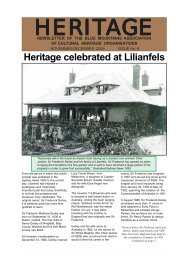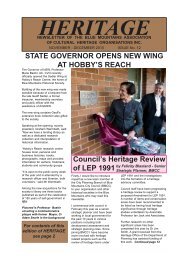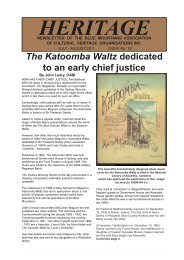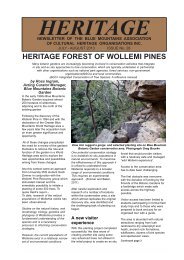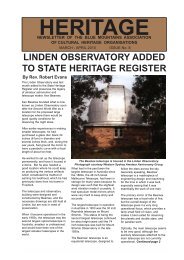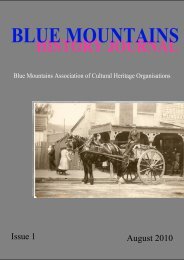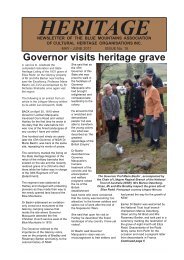Blue Mountains History Journal Issue 2
Blue Mountains History Journal Issue 2
Blue Mountains History Journal Issue 2
You also want an ePaper? Increase the reach of your titles
YUMPU automatically turns print PDFs into web optimized ePapers that Google loves.
<strong>Blue</strong> <strong>Mountains</strong> <strong>History</strong> <strong>Journal</strong> 2; 2011<br />
platform, so someone had to ride 32 km (20 miles) each day to deliver out-going mail and collect the<br />
in-coming mail, especially in the months from November to April when most of the property owners<br />
were in residence. Between May and October caretakers and workers had to survive as best they could.<br />
A letter from Mr. F.G. Davies, the store keeper at One Tree Hill, written to the Post Master-General in<br />
January 1877 provides valuable information about those first years of European settlement at Mt. Wilson<br />
(Davies 1877). In January 1877 only three families were residing there: Wynne, Merewether and Du<br />
Faur. There is no reference to the other families who came to settle – Cox, Gregson and Stephen. It<br />
reinforces the fact that Richard Wynne was the first to settle and it demonstrates a connection between<br />
him and Eccleston Du Faur. There does not seem to be any doubt as to the Commissioner’s support<br />
for Mr. Wynne’s scheme, yet his word did not always reach the lower ranks. Mr. Davies’ letter reveals<br />
that the system of receiving letters proposed by Mr. Wynne was not proceeding at all smoothly owing<br />
to the lack of cooperation the Railways staff and the lack of security for the mail. In other words the<br />
Commissioner of Railways’ instructions in 1876 were not being followed. On 29 January 1877 the<br />
Secretary to the Post Master General commented:<br />
“the key may be sent to Mr. Wynne with a letter and he had better be informed of the ‘uncertainty<br />
of the train stopping’! He can then see the Railway Authorities of he wishes.”<br />
Here is a subtle change! The Secretary is saying –‘ I have done all I can, and after all, the Railway<br />
Commissioner had assured everyone that all would be well in 1876. Now it is up to Mr. Wynne to<br />
tackle the Railway Authorities!’ For much of 1877 this system, with the uncertainty of the train stopping<br />
and lack of security for letters staggered on. Whether Richard Wynne approached the Railway<br />
Commissioner is not clear.<br />
On 23 March 1878 our sources tell us that a remarkable event had taken place. Michael Hogan had<br />
been appointed to operate at the Mt. Wilson Platform as it had become a Crossing Station (Wynne<br />
1878).<br />
At Mt. Wilson Platform<br />
“A crossing loop, with telegraph office, were added in 1877.” (Wylie & Singleton 1958, p.93)<br />
on the western side allowing trains travelling in opposite directions along the single-line track to pass<br />
after one had pulled into the loop line. More significantly, Mr. Hogan was diligently looking after the<br />
Box for the residents of Mt. Wilson, and they were most pleased. A letter signed by Mr. Wynne on 23<br />
March 1878 began with the words:<br />
“We require a Post Office at Mt Wilson Platform.”<br />
The following points were listed<br />
(a.) his letters delivered to Mt. Victoria were often delayed by 12-14 hours,<br />
(b.) 60-70 persons were now residing at Mt. Wilson,<br />
(c.) Mr. Hogan was conversant with telegraphy and would gladly take charge of a Post Office at the<br />
Platform, and<br />
(d.) 77 letters were received and 69 despatched in the week ending 21 March 1878.<br />
The authorities took some convincing to appoint Mr. Hogan. In April 1878 Richard Wynne wrote<br />
again stating these reasons for a Post Office:<br />
(1.) being unable to liquidate debts through your office as is the custom where a Post Office is available<br />
for registering letters or granting Post Office orders,<br />
(2.) we are 9 miles [15 km] by road from the Platform and 6 miles [9 km] by rail from Mt Victoria,<br />
(3.) the population is increasing and we seriously feel the want of postal accommodation.<br />
While the Railway Department agreed that Mr. Hogan could undertake those extra duties the General<br />
Post Office hesitated but in February 1879 agreed that Mr. Hogan could become “A Receiving Officer”<br />
which meant that he only received mail and forwarded it on. While arguments continued over the<br />
number of letters passing through Mt. Wilson Platform, on 26 February 1879 the Post Master-General<br />
appointed Mr. Hogan as Post Master at Mt. Wilson Platform, guaranteed by Richard Wynne, a<br />
gentleman, and Mr. George Brown, a blacksmith from Darlinghurst Road, and at the sum of £11 per<br />
year.<br />
39 Back to Contents




